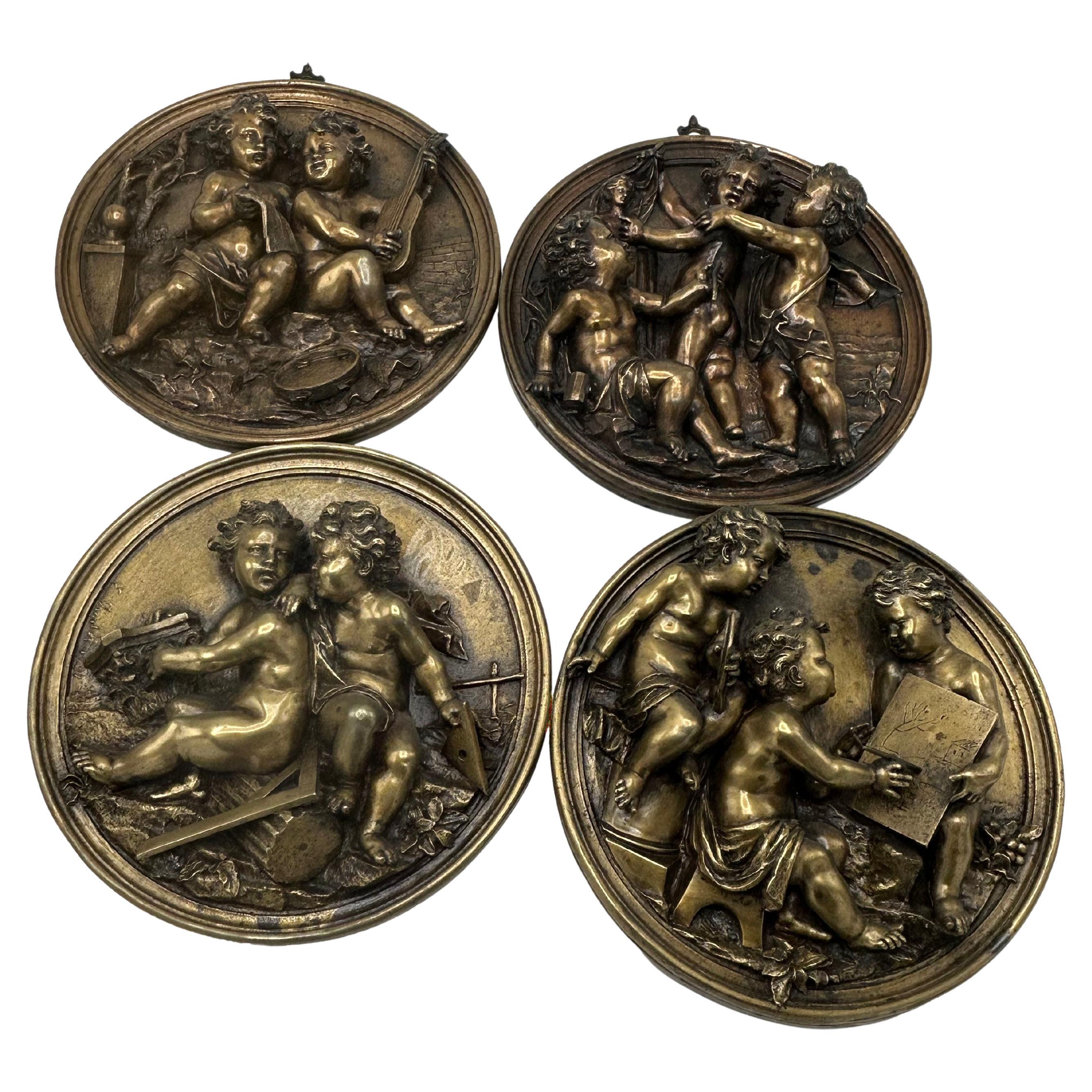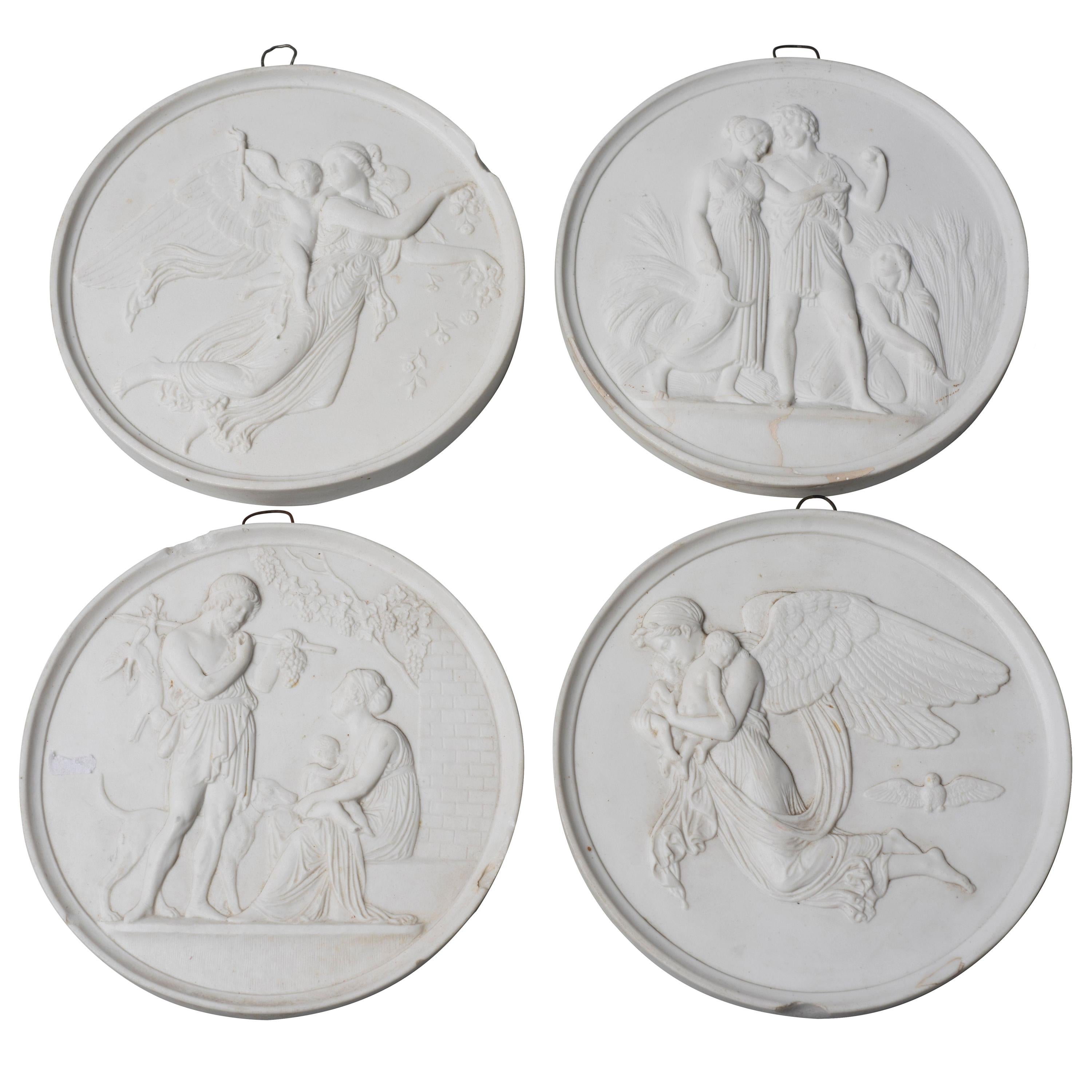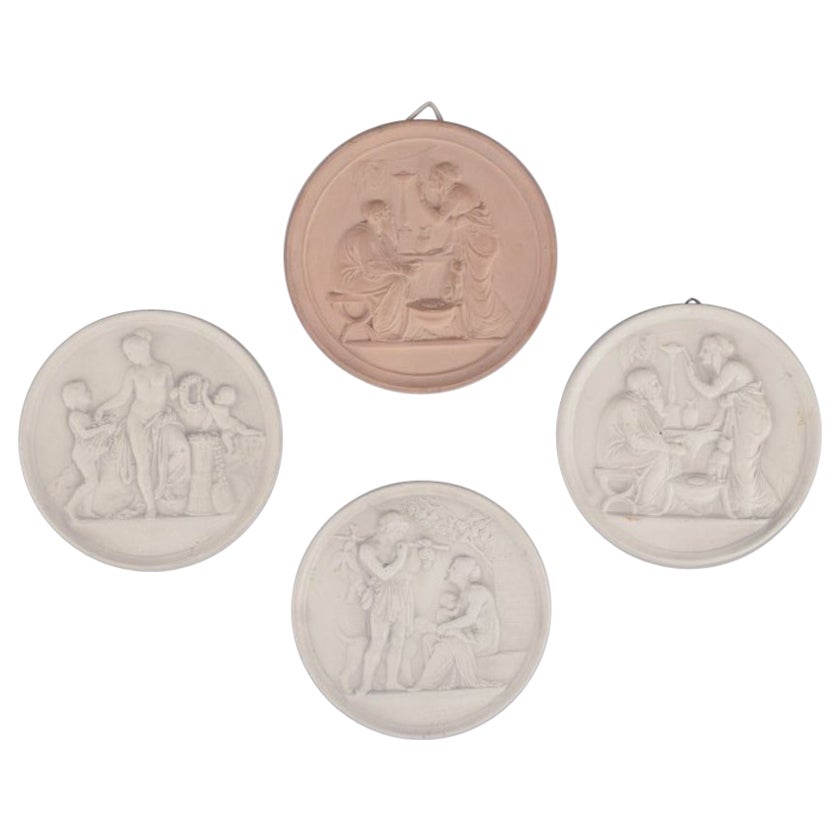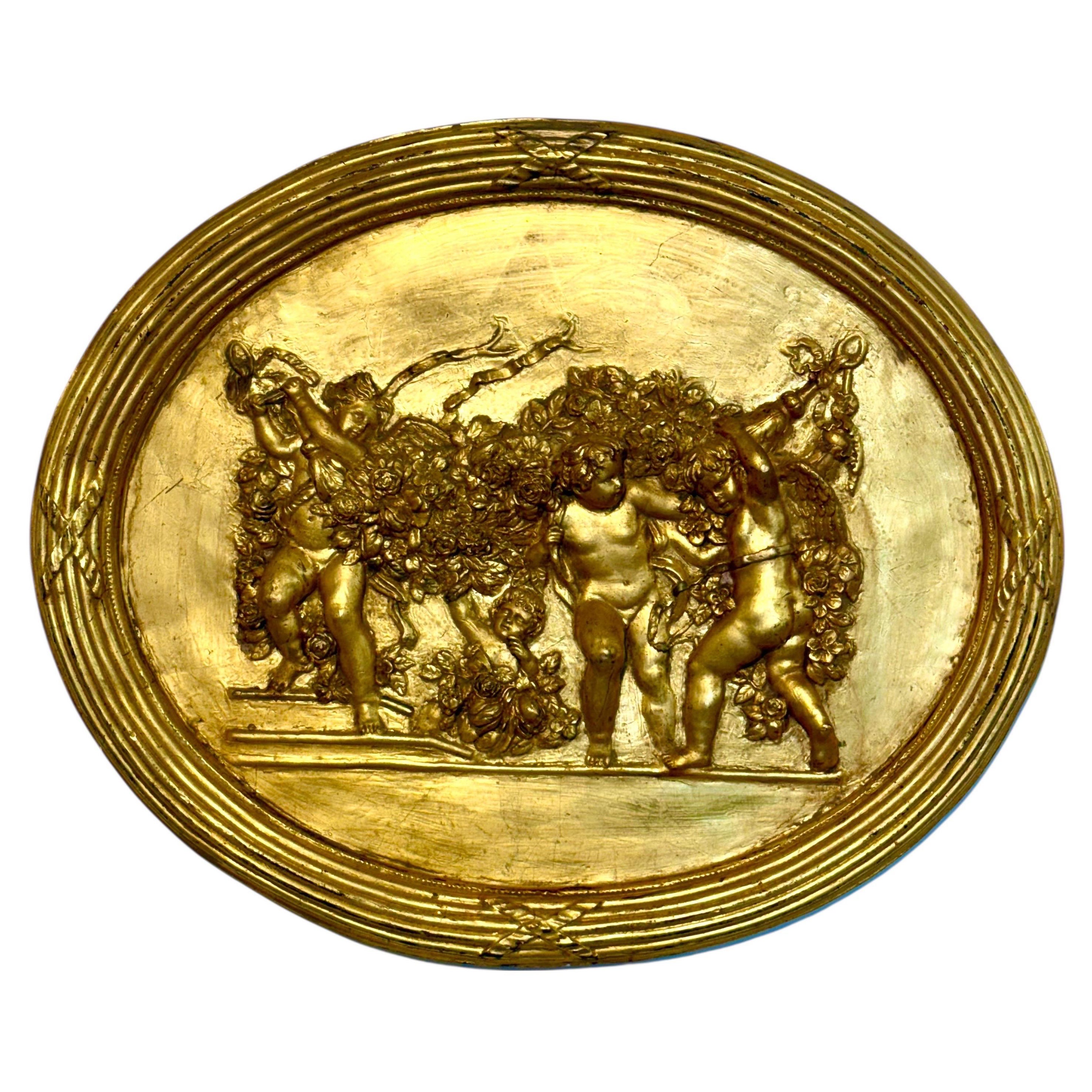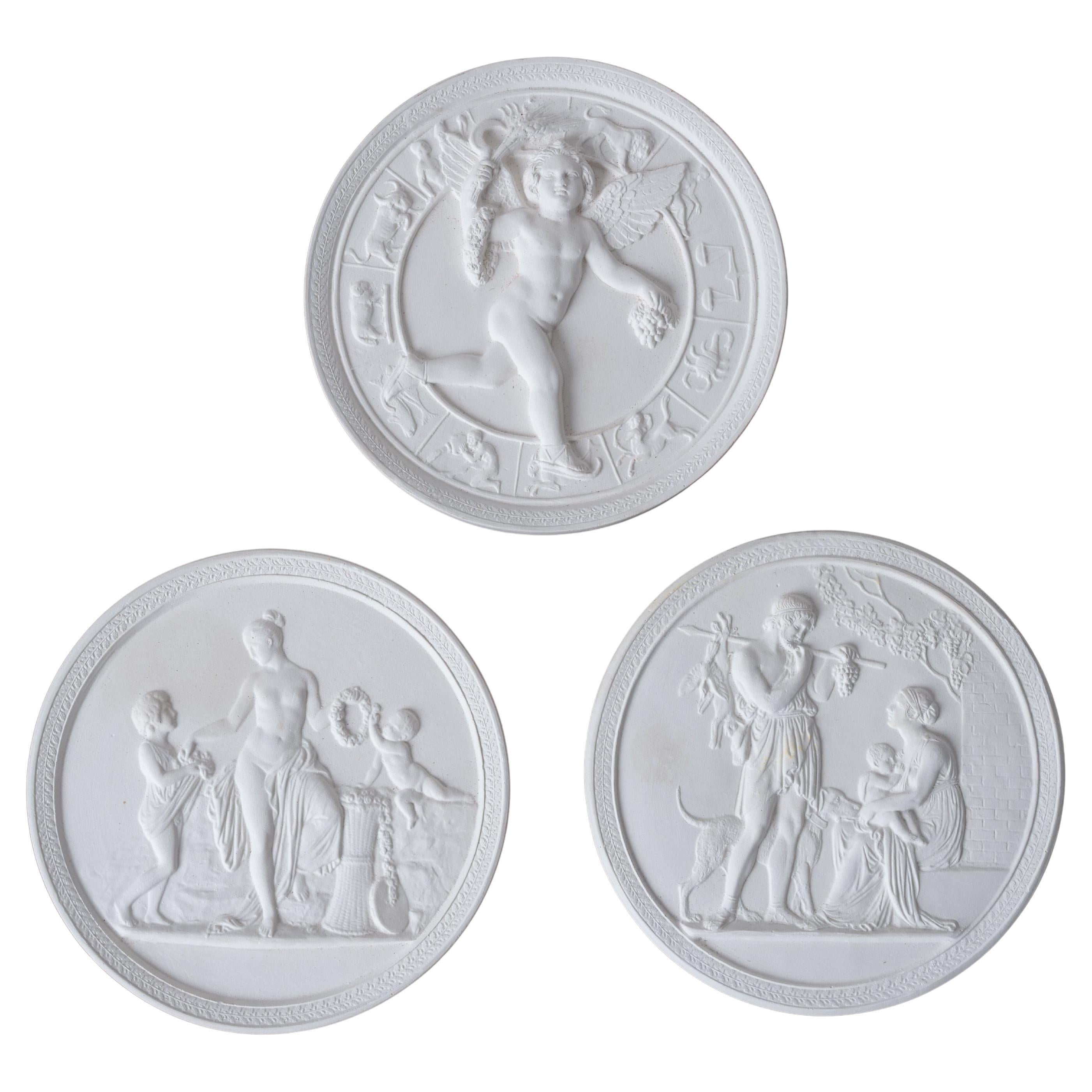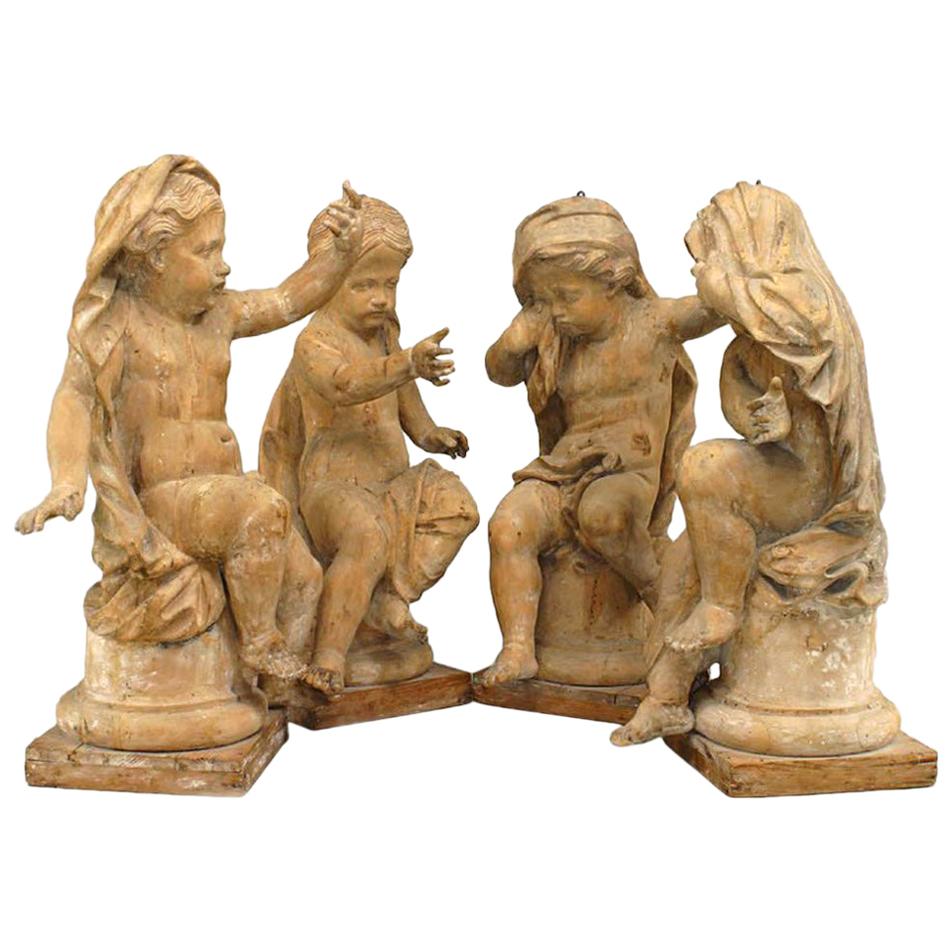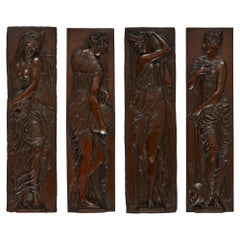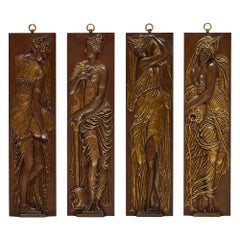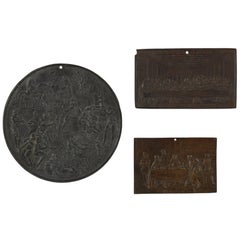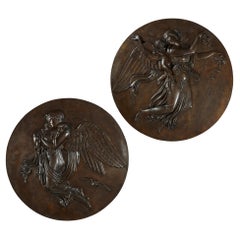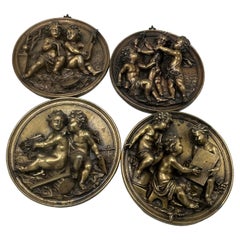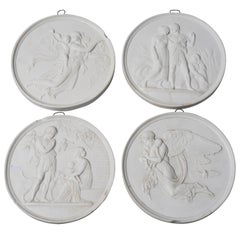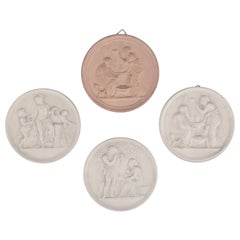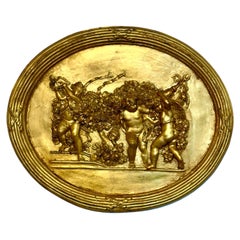Items Similar to Set of Four Antique Ormolu Roundels by Mathurin Moreau
Want more images or videos?
Request additional images or videos from the seller
1 of 11
Set of Four Antique Ormolu Roundels by Mathurin Moreau
$16,477.46per set
£12,000per set
€14,044.43per set
CA$22,731.81per set
A$24,988.51per set
CHF 13,132.81per set
MX$303,451.53per set
NOK 163,828.57per set
SEK 155,216.05per set
DKK 104,817.13per set
About the Item
Set of four antique ormolu roundels by Mathurin Moreau
French, Late 19th Century
Height 3cm, diameter 44cm
This set of four sculptural panels is crafted by the renowned French metalworker Mathurin Moreau (1822-1912). From a family of sculptors, Moreau is known for his lifelike bronzes cast in the Academic style.
Each circular plaque features a high-relief frieze of putti, surrounded by a raised border. Each plaque depicts a different scene of a trio of putti; the cherubs can be seen riding mythical birds and fish, forging weapons, and harvesting crops. The scenography is typical of the 19th century Neoclassical style, which often depicted mischievous or charming cherubs in natural settings. The figures are crafted in the impressive high-relief style Moreau is known for, standing out against the shallower backdrops.
Each roundel is signed ‘Math. Moreau’ along the lower border.
With their impressive craftsmanship and undeniable charm, this set of bronzes would undoubtedly make a fine addition to any collection of antiques.
- Creator:Mathurin Moreau (Artist)
- Dimensions:Height: 1.19 in (3 cm)Diameter: 17.33 in (44 cm)
- Sold As:Set of 4
- Style:Neoclassical (In the Style Of)
- Materials and Techniques:
- Place of Origin:
- Period:
- Date of Manufacture:Late 19th Century
- Condition:Wear consistent with age and use.
- Seller Location:London, GB
- Reference Number:Seller: 173061stDibs: LU956339306082
Mathurin Moreau
Mathurin Moreau was a renowned French sculptor born on November 18, 1822, in Dijon, France, into a family of artists. He was the son of sculptor Jean-Baptiste Moreau and the brother of sculptors Hippolyte and Auguste Moreau, thus part of a dynasty that significantly influenced French sculpture in the 19th century. Educated at the École des Beaux-Arts under the tutelage of Étienne-Jules Ramey and Augustin-Alexandre Dumont, Moreau went on to become a prominent figure in the French art scene. He was known for his exceptional skills in crafting bronze sculptures, which are among the most celebrated aspects of his artistic legacy. Moreau debuted at the Salon in 1848 and rapidly gained acclaim. His works often depicted allegorical figures, mythological scenes, and typical rural life, capturing both the idealistic beauty and the detailed realism that were hallmarks of the period's sculpture. Many of his bronzes were cast by the famous Val d'Osne foundry, which helped ensure the high quality of his pieces. The foundry was known for its superb craftsmanship and was one of the primary mediums for Moreau’s creations. Throughout his career, Mathurin Moreau received numerous awards, including a medal of honor at the Exposition Universelle in 1878. He was also made a Knight of the Legion of Honor in 1865 and rose to become an officer of the order in 1885. His artworks were not only celebrated in France but also internationally, as his bronzes found homes in diverse locations, from Parisian squares to foreign collections. Moreau's works are characterized by their classical style, attention to detail, and the expressive beauty of their subjects. Some of his notable bronze sculptures include allegorical representations such as "La Danse" and "L’Eau". These pieces exemplify his ability to translate ethereal themes into tangible beauty, making his sculptures highly sought after by collectors and museums worldwide. Mathurin Moreau passed away in 1912, leaving behind a rich legacy of artistic achievement that continues to be celebrated and revered in the art world today. His sculptures, especially his bronzes, remain valuable for their artistic and historical significance, often fetching high prices at auctions and retaining a place of prominence in collections of 19th-century French art.
About the Seller
5.0
Recognized Seller
These prestigious sellers are industry leaders and represent the highest echelon for item quality and design.
Gold Seller
Premium sellers maintaining a 4.3+ rating and 24-hour response times
Established in 1975
1stDibs seller since 2012
415 sales on 1stDibs
Typical response time: 5 hours
Associations
The British Antique Dealers' AssociationInternational Confederation of Art and Antique Dealers' Associations
- ShippingRetrieving quote...Shipping from: London, United Kingdom
- Return Policy
Authenticity Guarantee
In the unlikely event there’s an issue with an item’s authenticity, contact us within 1 year for a full refund. DetailsMoney-Back Guarantee
If your item is not as described, is damaged in transit, or does not arrive, contact us within 7 days for a full refund. Details24-Hour Cancellation
You have a 24-hour grace period in which to reconsider your purchase, with no questions asked.Vetted Professional Sellers
Our world-class sellers must adhere to strict standards for service and quality, maintaining the integrity of our listings.Price-Match Guarantee
If you find that a seller listed the same item for a lower price elsewhere, we’ll match it.Trusted Global Delivery
Our best-in-class carrier network provides specialized shipping options worldwide, including custom delivery.More From This Seller
View AllSet of Four Spelter Plaques by Ferdinand Barbedienne
By Ferdinand Barbedienne
Located in London, GB
Set of four spelter plaques by Ferdinand Barbedienne
French, late 19th century
Measures: Height 45cm, width 12cm, depth 0.5 cm
This set of four pla...
Category
Antique Late 19th Century French Neoclassical Figurative Sculptures
Materials
Spelter
Four Antique Bronze Plaques Depicting Water-Nymphs, by Ferdinand Barbedienne
By Ferdinand Barbedienne
Located in London, GB
Four antique bronze plaques depicting water-nymphs, by Ferdinand Barbedienne
French, 19th century.
Measures: Height 47cm, width 12cm, depth 2.5cm
Finely cast in relief from patinated bronze with parcel gilt patina, these French 19th Century panels each depict a Classical female water-nymph. The relief structure and design is after four panels from the important marble fountain from the Renaissance period in Paris called the Fontaine des Innocents. This was created by the French sculptor Jean Goujon...
Category
Antique 19th Century French Renaissance Figurative Sculptures
Materials
Bronze
$10,298 / set
Free Shipping
Three German Antique Iron Plaques Cast in the Renaissance Style
Located in London, GB
This charming set of three antique German plaques are each cast from high quality 19th century iron, meaning that the detailing on them is of a very hig...
Category
Antique 19th Century German Renaissance Figurative Sculptures
Materials
Iron
Large Pair of Circular, Patinated Bronze Relief Plaques of Night and Day
Located in London, GB
A pair of patinated bronze antique plaques of Night and Day
French, Late 19th Century
80cm in diameter, 5cm in depth
Modelled after Bertel Thorvaldsen's iconic 'Night and Day' relie...
Category
Antique Late 19th Century French Neoclassical Decorative Art
Materials
Bronze
Large Gilt, Patinated Bronze and Marble Clock Set by Raingo Frères
By Raingo Frères
Located in London, GB
Large gilt, patinated bronze and marble clock set by Raingo Frères
French, Late 19th Century
Clock: height 73cm, width 29cm, depth 28cm
Candelabra: height 66cm, width 30cm, depth ...
Category
Antique Late 19th Century French Neoclassical Mantel Clocks
Materials
Marble, Bronze, Ormolu
Set of Three Patinated Copper Panels with Repoussé Scenes
Located in London, GB
These three circular copper panels were crafted in the 19th century in France. They are decorated with biblical and Christian themes taken from the lives of King Solomon (d. 931 BC) ...
Category
Antique 19th Century French Renaissance Wall-mounted Sculptures
Materials
Copper
You May Also Like
Bronze plaques "The Arts" signed
Located in Autonomous City Buenos Aires, CABA
Signed Bronze Plaques "The Arts"
Lot of signed bronze plaques with a dark aged patina. Each plaque features a relief figure representing one of "The Arts." The bas-relief designs are...
Category
20th Century French Neoclassical Wall-mounted Sculptures
Materials
Bronze
Neoclassical Medals, Italy, 19th Century
Located in Roma, IT
Neoclassical Medals are beautiful decorative objects.
Four circular plates in the precious biscuit porcelain with mythological subjects, and an evident Neoclassical taste. Realize...
Category
Antique 19th Century Italian Neoclassical Decorative Art
Materials
Porcelain
$1,077 / set
Four round wall reliefs in plaster. Ca 1900
Located in København, Copenhagen
Four round plaster reliefs including Bertel Thorvaldsen motifs and biblical motifs.
Circa 1900.
In good condition with a few minor chips.
Hanging attachments on the backs.
Dimensions...
Category
Early 20th Century Scandinavian Neoclassical Decorative Art
Materials
Plaster
19th Century Gilded Plaster Oval Bas-Relief with Putti and Garlands
Located in LA CIOTAT, FR
This refined oval bas-relief in gilded plaster is a remarkable example of 19th century decorative art in the neoclassical tradition. The composition depicts a lively scene of playful...
Category
Antique 19th Century French Wall-mounted Sculptures
Materials
Plaster
Bertel Thorvaldsen - Bing & Grøndahl Roundels, 19th Century
By Bertel Thorvaldsen
Located in Savannah, GA
A set of 3 Bing & Grøndahl bisque roundels after Bertel Thorvaldsen, 19th Century.
5 ⅜ inches wide by ½ inches deep
Category
Antique 19th Century European Wall-mounted Sculptures
Materials
Plaster
Set of 4 Louis XVI Wooden Seasonal Putti
Located in Queens, NY
Set of 4 French Louis XVI style (18th Cent) stripped wood life-size putti depicting the four seasons sitting on socle bases. (after the marble models by Camillo Rusconi)
Category
Antique 18th Century French Louis XVI Figurative Sculptures
Materials
Wood
$160,000 / set
Read More
Exquisite Sèvres Porcelain Brings More to the Table than Dishes
The elegant ceramics represent the best of French artistry and innovation.
What Is Ormolu, and Why Are We Talking about It?
This golden material glamorized neoclassical furnishings and transformed upper-crust sitting rooms from France to Philadelphia in the 18th and early 19th centuries.
More Ways To Browse
Antique Roundel
Relief Frieze
Math Moreau
Andalusian Furniture
Arrow Sculpture
Art Deco Archer
Banana Sculpture
Berrocal Puzzle
Brass Flower Sculpture
Bronze Diana The Huntress
Bronze Fisherman
Bronze Gladiator
Bronze Sculpture Nymph
Bronze Sculpture Of Mercury
Chariot Sculpture
Fairy Sculpture
Farmer Sculpture
Geisha Study
